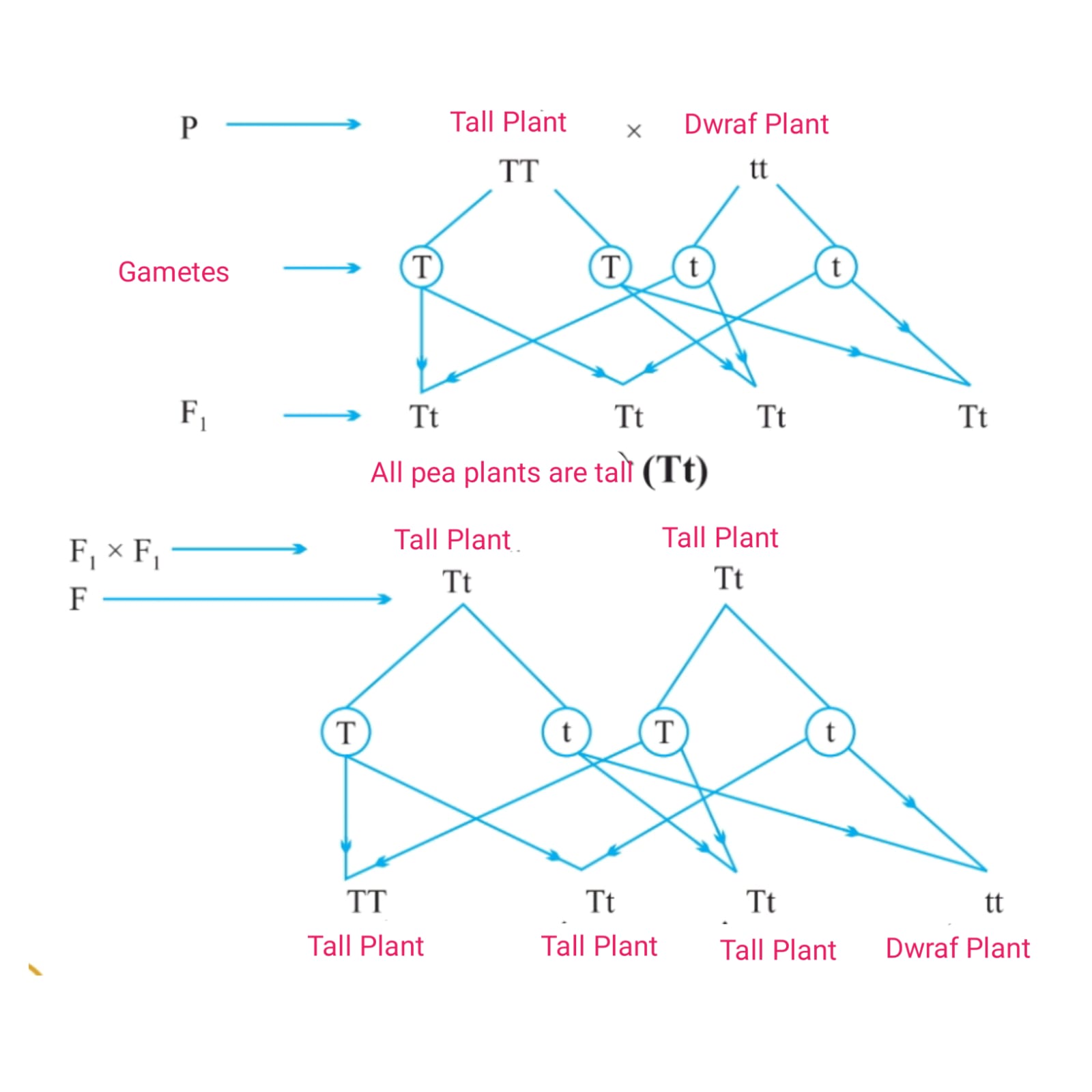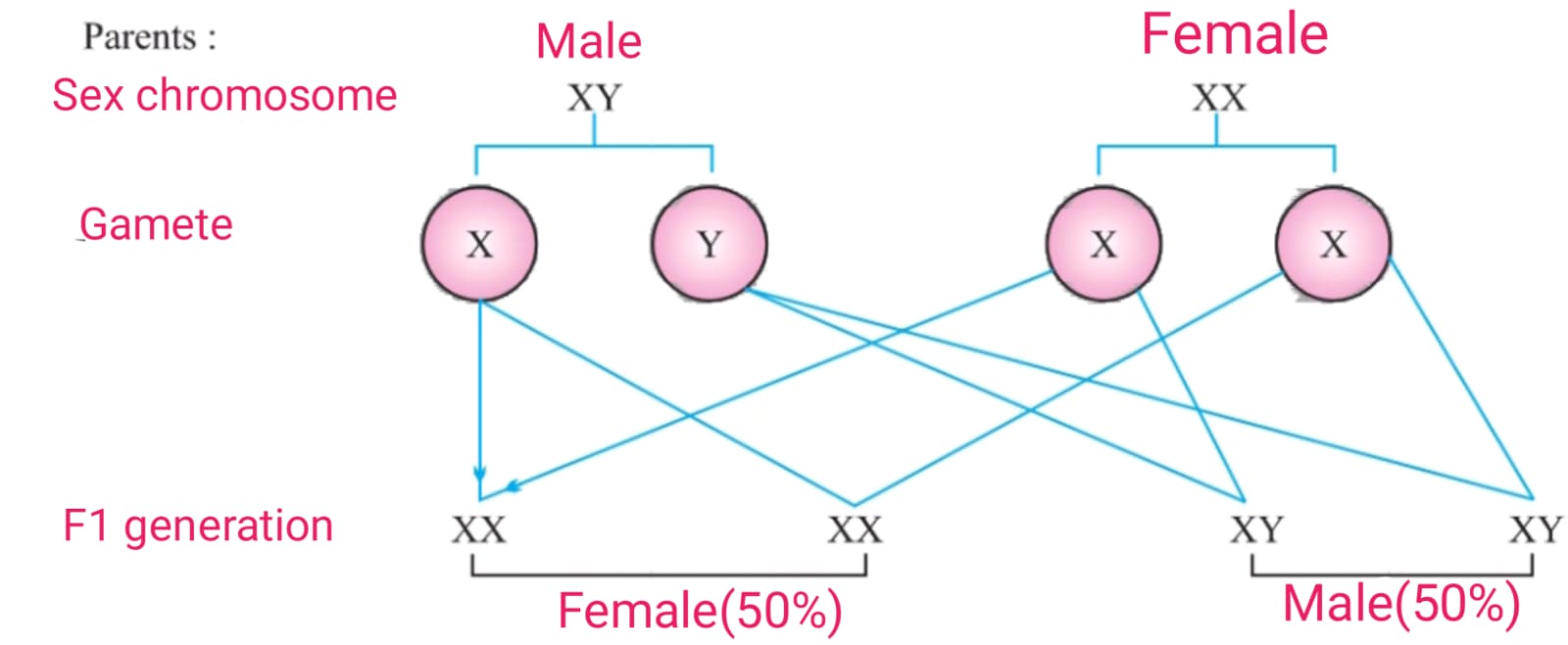Heredity and Evolution
Genetics
- Genetics is a branch of biology that deals with the study of genes, genetic variation, and heredity in living organisms.
- It helps understand the transmission of traits and characteristics from one generation to the next.
Heredity
- Heredity refers to the transmission of traits from parents to offspring. This process occurs through genes that carry genetic information.
- Examples include skin color, eye color, and hair texture. Heredity plays a crucial role in determining the physical traits and development of offspring.
Gene
A gene is a segment of DNA (Deoxyribonucleic Acid) that regulates the traits of an organism. It transfers genetic information from parents to offspring. Each gene is responsible for a specific biological function. Genes are located on chromosomes within the nucleus of cells.
Functions of Genes:
- Genes control the production of proteins necessary for the development of traits and characteristics.
- They influence genetic disorders, body structure, and even behavior.
- Each gene performs a specific role, such as determining eye color, blood group, or height.
- Examples:
- Blood group is determined by the ABO gene.
- Hemoglobin production is controlled by the HBB gene.
- Genes like OCA2 and HERC2 are responsible for eye color.
Types of Traits
1. Acquired Traits:
- Acquired traits do not cause changes in DNA.
- These traits develop during an organism's lifetime and are not passed to the next generation.
- Examples: Muscle development, learning music.
2. Inherited Traits:
- Inherited traits involve changes in genes.
- These traits are passed from parents to offspring.
- Examples: Height, skin color, eye color.
Variation
- Variation refers to the differences found among individuals of a species.
Examples: Eye color, Hair color, Skin color
Importance of Variation:
- Encourages natural selection.
- Aids in adaptation and survival.
- Plays a vital role in evolution.
- Makes organisms resistant to diseases and environmental changes.
Gregor Mendel's Experiments
- Gregor Mendel conducted experiments on pea plants and studied the results of monohybrid and dihybrid crosses.
Reasons for Choosing Pea Plants (Pisum sativum):
(a). Distinct Contrasting Traits:
Pea plants have traits like seed color (yellow or green), seed texture (round or wrinkled), and flower color (purple or white) that are easy to study.
(b). Self-Pollination:
Pea plants naturally self-pollinate, ensuring pure lines.
(c). Controlled Pollination:
Mendel could easily perform cross-pollination to study different traits.
(d). Short Life Cycle:
A short life cycle allowed the study of multiple generations in a short time.
(e). Large Number of Offspring:
Pea plants produce many seeds, making statistical analysis easier.
(f). Hybridization:
Hybrids could easily be developed to study new traits.
(g). Stable Inheritance:
Traits remained stable across generations, simplifying conclusions.
| Trait |
Dominant Trait |
Recessive Trait
|
| Seed Shape |
Round |
Wrinkled |
| Seed Color |
Yellow |
Green |
| Seed Color |
Inflated |
Constricted |
| Pod Shape |
Green |
Yellow |
| Flower Color |
Purple |
White |
| Flower Position |
Axial |
Terminal |
| Plant Height |
Tall |
Dwarf |
Mendel discovered laws of inheritance, which remain crucial to the study of genetics.
Monohybrid Cross
A monohybrid cross is a type of genetic experiment that focuses on the inheritance of a single trait or characteristic. Mendel conducted this experiment on pea plants to study the inheritance of the plant height trait. He used two parent plants: one tall plant (TT) and one dwarf plant (tt) and observed how the trait of height passed on through generations.
Parent Generation (P Generation)
- Tall plant (TT): It has two dominant alleles (T) for height.
- Dwarf plant (tt): It has two recessive alleles (t) for height.
- These two plants were cross-pollinated to study their offspring.
F1 Generation (First Filial Generation)
- After cross-pollination, all offspring in the F1 generation were tall (Tt).
- This happened because the dominant allele (T) masked the effect of the recessive allele (t).
- Result in F1 Generation:
- Phenotype (Physical Trait): All plants were tall.
- Genotype (Genetic Makeup): All plants were heterozygous (Tt).
F2 Generation (Second Filial Generation)
- The F1 generation plants (Tt) were allowed to self-pollinate to produce the F2 generation.
- In the F2 generation, a ratio of 3:1 was observed for tall and dwarf plants.
- F2 Generation Results:
- Phenotypic Ratio: 3 tall : 1 dwarf.
- Genotypic Ratio: 1 TT : 2 Tt : 1 tt.
- TT, tt : Homozygous dominant (tall).
- Tt: Heterozygous (tall, as the dominant allele masks the recessive allele).

Dihybrid Cross
A dihybrid cross is an experiment that studies the inheritance of two different traits simultaneously. Mendel performed this experiment to analyze how two traits are inherited together and whether they affect each other during transmission to the next generation.
Example Studied by Mendel
Mendel studied the traits of seed color and seed texture in pea plants:
- Seed color: Yellow (Y, dominant) and Green (y, recessive).
- Seed texture: Round (R, dominant) and Wrinkled (r, recessive).
Parent Generation (P Generation)
- Yellow and Round (YYRR) × Green and Wrinkled (yyrr).
- These two plants were cross-pollinated.
F1 Generation (First Filial Generation)
- All offspring in the F1 generation were yellow and round seeds with the genotype YyRr.
- This occurred because the dominant alleles for both traits (Y and R) masked the recessive alleles (y and r).
- Result in F1 Generation:
- Phenotype (Physical Traits): All plants had yellow and round seeds.
- Genotype (Genetic Makeup): All plants were heterozygous for both traits (YyRr).
F2 Generation (Second Filial Generation)
- The F1 generation plants (YyRr) were allowed to self-pollinate, producing the F2 generation.
- The F2 generation exhibited a phenotypic ratio of 9:3:3:1, showing 16 possible combinations of traits.
Detailed Results of F2 Generation
1. Punnett Square for F2 Generation (16 Combinations):
| |
YR |
Yr |
yR |
yr |
| YR |
YYRR |
YYRr |
YyRR |
YyRr |
| Yr |
YYRr |
YYrr |
YyRr |
Yyrr |
| yR |
YyRR |
YyRr |
yyRR |
yyRr |
| yr |
YyRr |
Yyrr |
yyRr |
yyrr |
2. Phenotypic Ratio (Based on Physical Traits):
- 9 Yellow and Round (YYRR, YYRr, YyRR, YyRr).
- 3 Yellow and Wrinkled (YYrr, Yyrr).
- 3 Green and Round (yyRR, yyRr).
- 1 Green and Wrinkled (yyrr).
3. Genotypic Combinations:
- Yellow and Round: YYRR, YYRr, YyRR, YyRr.
- Yellow and Wrinkled: YYrr, Yyrr.
- Green and Round: yyRR, yyRr.
- Green and Wrinkled: yyrr.
Mendel’s Laws
Law of Dominance:
Out of two alleles, one is dominant, and the other is recessive.
Law of Segregation:
Each gene has two alleles that separate during gamete formation, ensuring that only one allele is passed to the offspring.
Law of Independent Assortment:
Different traits are inherited independently of each other.
Sex Determination in Humans
- Humans have 46 chromosomes in each cell, arranged in 23 pairs.
- Autosomes (22 pairs): These are similar in males and females.
- Allosomes (1 pair): These differ in males and females.
- Female: XX chromosomes
- Male: XY chromosomes
The male sperm carries either an X or Y chromosome, while the female egg always carries an X chromosome: If the sperm carries X: result Female (XX). If the sperm carries Y: result Male (XY)








